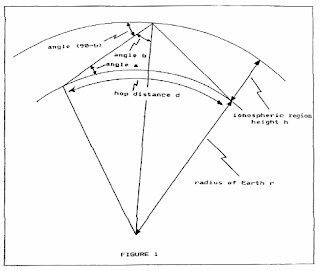Elevation Angles Required for 6m Sporadic E Carl Luetzelschwab K9LA.
Model of Earth-Ionosphere System
The model of the Earth-ionosphere system is shown in Figure 1.
From spherical geometry, three equations are used to determine the hop distance d, the
angle b, and the M-factor (the M-factor is the MUF divided by the critical frequency):
hop distance d = 2 r {90 – a – sin-1[r sin(a + 90) / (r + h)]} / 57.3
angle b = sin-1[(r / r + h) sin (a + 90)]
M-factor = 1 / [sin(90-b)]
For the hop distance d in km, the radius of the Earth r is assumed to be 6371 km.
Required foEs
Using the three equations in the previous section, the hop distance and required sporadic
E critical frequency foEs for various elevation angles can be calculated. This data is
shown in Table 1. The height of the Es layer is assumed to be 105 km, and the operating
frequency is assumed to be 50.1 MHz.
Maximum Mid-Latitude foEs Values
Data from several mid latitude ionosondes in the North American sector (Dyess AFB,
Wallops Island, Millstone Hill, and Boulder) were reviewed for maximum foEs values
during the summer of 2006 (June 1 through August 31).
The highest foEs value observed was 11.9 MHz. To allow for higher foEs values that
would occur at a very low probability, this value was increased by 25% to about 15 MHz.
From Table 1, this 15 MHz value says 6m sporadic E propagation is limited to a
minimum distance of around 700 km, which requires an elevation angle of about 15o. For
Es at shorter distances on 6m, there simply isn’t enough ionization to refract energy at
angles higher than about 15o.
Elevation Angles Required for 6m Sporadic E
The conclusion of this analysis is that elevation angles from 0o to 15o are important for
6m sporadic E propagation.
Carl Luetzelschwab K9LA
21 October 2006 [unpublished]
Tim M0BEW.


No comments:
Post a Comment